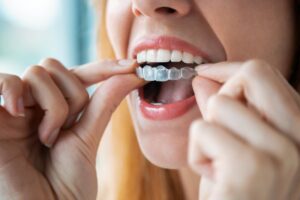
When people think of Invisalign, they often picture straighter teeth and a more confident smile. While it’s true that Invisalign aligners are excellent for correcting crowding and gaps, many patients wonder if they can also address more complex bite problems. The good news is that Invisalign has advanced significantly over the years and can now treat a wide range of bite issues. Let’s explore how Invisalign works, which bite problems it can correct, and what to expect during treatment.
Understanding Bite Problems
A “bite problem,” or malocclusion, occurs when the upper and lower teeth don’t fit together properly. Common bite issues include:
- Overbite: The upper front teeth overlap the lower teeth too much.
- Underbite: The lower teeth sit in front of the upper teeth.
- Crossbite: Some upper teeth sit inside the lower teeth when you bite down.
- Open bite: The upper and lower teeth don’t touch when the mouth is closed.
These issues aren’t just cosmetic—they can lead to uneven tooth wear, jaw pain, difficulty chewing, and even speech problems if left untreated.
How Invisalign Works for Bite Problems
Invisalign aligners use a series of clear, removable trays that gradually shift teeth into better alignment. Each set of aligners is worn for about 1–2 weeks before moving to the next stage. For bite problems, Invisalign may also incorporate special attachments (tiny tooth-colored bumps bonded to teeth), elastics, or precision cuts to help move the jaw into the correct position.
In the past, Invisalign was considered best for mild to moderate cases. However, with technological advances such as SmartForce® attachments and digital treatment planning, Invisalign can now treat many moderate to complex bite problems that once required traditional braces.
Bite Problems Invisalign Can Fix
- Overbite: Invisalign can move the upper teeth back and the lower teeth forward, reducing excessive overlap.
- Underbite: Aligners combined with elastics can help shift the lower jaw into a healthier position.
- Crossbite: Invisalign can guide specific teeth outward or inward to achieve proper alignment.
- Open bite: Aligners can help close the gap between upper and lower teeth by moving them into contact.
That said, very severe bite problems may still require traditional braces or even surgical intervention. A consultation with an orthodontist will determine the best option for your case.
Benefits of Invisalign for Bite Correction
- Discreet treatment: The clear aligners are nearly invisible.
- Comfort: Smooth plastic trays are gentler on the cheeks and gums than brackets and wires.
- Removability: You can take aligners out for meals, brushing, and flossing.
- Predictable results: Advanced 3D imaging lets you preview your bite correction before starting treatment.
Yes, Invisalign can fix many types of bite problems, from mild misalignments to more complex cases. While not every patient is a candidate, Invisalign continues to expand its capabilities, making it a great option for those seeking both function and aesthetics in their orthodontic treatment. If you suspect you have a bite issue, schedule a consultation with a dentist to find out if this modern, discreet solution is right for you.
About the Practice
Would you like to straighten your teeth or fix a bite problem? Our expert team at Serenity Orthodontics can help you with clear Invisalign aligners. Our certified orthodontists will provide you with the very best treatment available and have custom designed aligners for each of our patients. We also use modern technology like an iTero scanner to give you a preview of the end results. Don’t delay any longer, schedule an appointment online or call one of our conveniently located offices in your area.
